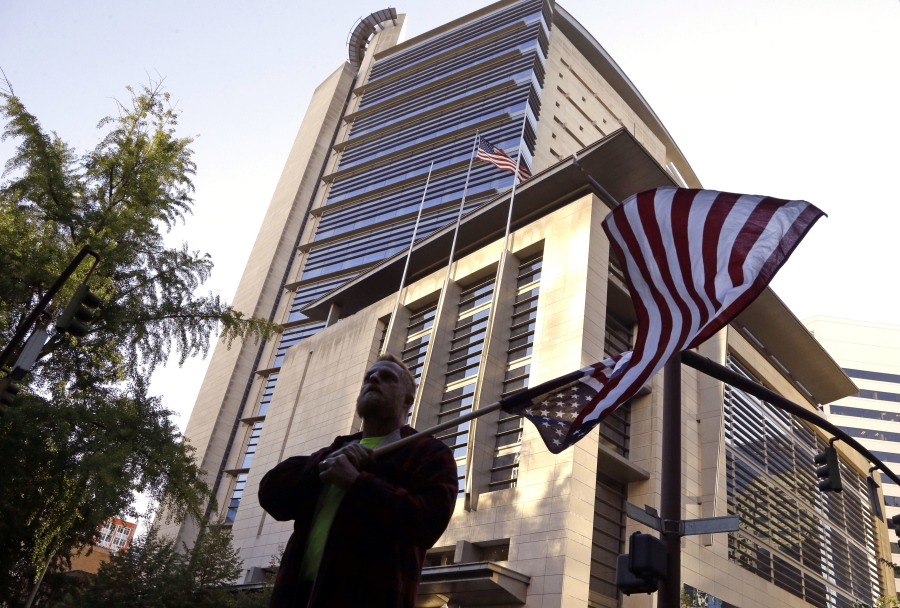PORTLAND — The armed occupiers who seized a remote bird sanctuary in Oregon early this year are being tried because their actions intimidated and threatened federal employees, not because they challenged the government’s land policies, a prosecutor said Tuesday as a trial began for seven people accused in the standoff.
During his opening statement, Geoffrey Barrow dismissed claims by group leader Ammon Bundy and others that the takeover was a legitimate protest of federal land management. Bundy and his brother Ryan, who’s also on trial, are part of a Nevada ranching family embroiled in a long-running dispute over land use.
“Everyone in this great nation has a right to his or her beliefs. We are not prosecuting the defendants because we don’t like what they think or said,” Barrow told jurors. “We are prosecuting them because of what they did.”
The occupation drew national attention to the decades-old fight between the federal government and Western states over land policy. After the land was seized, the government left the group alone for weeks until the last few holdouts abandoned the Malheur National Wildlife Refuge after 41 days.
The seven on trial are charged with conspiring to impede Interior Department employees from doing their jobs through intimidation or threats. Five are also charged with possession of a firearm in a federal facility.
Barrow said he will detail how the occupiers were divided into squads and drilled in hand-to-hand combat. He also said one of the participants in the standoff will testify against his former allies.
Marcus Mumford, the defense attorney for Ammon Bundy, said in his opening statement that the occupation had nothing to do with impeding federal employees.
Ammon Bundy “did what he did to demand accountability from the federal government,” Mumford said. “He demanded the federal government obey the law — the nerve.”
Bundy grew up the son of a rancher, Mumford said, and became a “reluctant activist” on matters involving government overreach and Western lands.
Mumford repeatedly asserted that Bundy was trying to legally take the refuge land by a practice known as adverse possession, which is a way to gain title to land by occupying it for a period of time.
U.S. District Court Judge Anna Brown stepped in to tell jurors that the concept of adverse possession is not being litigated.
Mumford ended his statement by noting that Bundy and his followers never aimed a gun at anyone.
Referencing the fatal shooting by police of occupation spokesman Robert “Lavoy” Finicum, he said only one side of the standoff shot someone. “And it wasn’t Mr. Bundy.”
Ryan Bundy, who is acting as his own attorney, told the court he came to help another ranching family he felt was being abused by the government.
“I felt we were not there to break the law but to enforce the law,” Ryan Bundy said, referring to the U.S. Constitution. “I am very in favor of government, as long as it’s done correctly.”
Before lunch, the judge rejected his request to hand each juror a pocket-sized copy of the Constitution.
About a dozen protesters showed up outside the federal courthouse in downtown Portland. They waved an upside-down American flag and marched around the building during the trial’s lunch break.
The standoff began as a protest against the imprisonment of two Oregon ranchers convicted of setting fires and quickly grew into demands for the U.S. government to turn public lands over to locals. The issue traces back to the 1970s and the Sagebrush Rebellion, a move by Western states such as Nevada to win more control of vast federal land holdings.
At the refuge near Burns, Oregon, protesters mostly came and went as they pleased. They changed the signs to “Harney County Resource Center” and said they would give the land to local officials to administer. The group held frequent news conferences and said they were doing maintenance and other work as they moved heavy equipment around.
The occupation roiled the surrounding area, with some locals supporting the movement and others denouncing the occupiers as unwanted outsiders.
Counterprotesters, including environmentalists, traveled to eastern Oregon and urged the federal government to administer public lands for the widest possible uses, for everyone from ranchers to bird watchers.
The nearby Burns Paiute Tribe also criticized the standoff, noting that the refuge contains prehistoric archaeological sites and that tribal members considered it part of their ancestral land.
Oregon officials, including Gov. Kate Brown, grew frustrated at how long it took federal authorities to move against the group. At one point, Brown sent a letter to U.S. Attorney General Loretta Lynch and FBI Director James Comey urging them to end the occupation “as safely and as quickly as possible.”
The Bundys were arrested in a Jan. 26 traffic stop that included the fatal shooting of Finicum, an occupation spokesman. Four holdouts stayed at the refuge for another 16 days.
A total of 26 people were charged with conspiracy. Eleven have pleaded guilty, including several from the Bundys’ inner circle. Charges were dropped against one. Seven defendants sought and received a delay in their trial, now scheduled for February.
The trial is expected to last until November.



